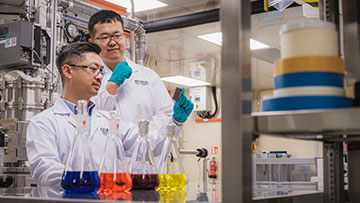
Scientists set a new benchmark in the power conversion efficiency of perovskite‒organic tandem solar cells. [Image: National University of Singapore]
An international team of researchers has developed a perovskite–organic tandem solar cell with the highest efficiency seen in a device of its kind (Nature, doi: 10.1038/s41586-025-09181-x). Their solar cell achieved a record power-conversion efficiency (PCE) of 26.7% in the lab—and was certified at 26.4% by an accredited independent photovoltaics calibration laboratory—over a 1-cm2 active area.
The value surpasses all certified PCEs recorded to date in centimeter-scale single-junction perovskite solar cells, perovskite–CIGS tandem cells, and perovskite–organic tandem cells. The design of a new narrow-bandgap organic absorber captures sunlight in the near-infrared (NIR) region, boosting efficiency and bringing perovskite–organic tandem solar cells another step closer to real-world applications.
“Thanks to their light weight and flexible form factor, perovskite–organic tandem solar cells are ideally suited to power applications that are run directly on devices such as drones, wearable electronics, smart fabrics and other AI-enabled devices,” said study author Yi Hou, National University of Singapore, Singapore, in a press release accompanying the research.
A new organic absorber
Metal halide perovskite solar cells have now reached PCEs over 26%, which rival those of silicon solar cells. Because they are approaching the fundamental efficiency limit that applies to all single-junction cells, scientists have been actively exploring tandem architectures.
In theory, combining perovskite and organic cells has several advantages, including higher efficiencies, better operational stability and similar processing technologies. However, the best-performing perovskite–organic solar cells up to this point haven’t met expectations. Since 2020, the PCE of perovskite–organic tandem solar cells has increased from under 17% to more than 24%—but still falls short compared with single-junction perovskite cells and perovskite–CIGS tandems with the same active area.
In theory, combining perovskite and organic cells has several advantages, including higher efficiencies, better operational stability and similar processing technologies.
To this end, Hou and his colleagues took on the challenge of finding a suitable narrow-bandgap organic absorber for the bottom cell. They strategically designed and synthesized P2EH-1V, a new asymmetric NFA with an optical bandgap of 1.27 eV, which effectively reduced the energy loss of the device while simultaneously broadening the photoresponse.
World-record efficiency
The researchers stacked a P2EH-1V subcell beneath a perovskite top cell, interfacing the two layers with a transparent conducting oxide-based interconnector. The tandem cell achieved a PCE of 27.5% on 0.05-cm2 samples and 26.7% on 1-cm2 devices. They also sent the 1-cm2 device to the Shanghai Institute of Microsystem and Information Technology, China, for certification, obtaining a certified PCE of 26.4% with no hysteresis.
“With efficiencies poised to exceed 30%, these flexible films are ideal for roll-to-roll production and seamless integration onto curved or fabric substrates—think self-powered health patches that harvest sunlight to run onboard sensors, or smart textiles that monitor biometrics without the need for bulky batteries,” said Hou.

